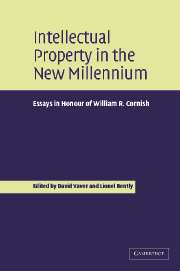Book contents
- Frontmatter
- Contents
- List of contributors
- Foreword
- Preface
- General intellectual property
- Patents and plant protection
- Trade marks and unfair competition
- Copyright, moral and neighbouring rights
- 15 The Berne Convention: the continued relevance of an ancient text
- 16 The (new?) right of making available to the public
- 17 Private copy licence and levy schemes: resolving the paradox of civilian and common law approaches
- 18 Paternalism and autonomy in copyright contracts
- 19 Criminality and copyright
- 20 Towards new forms of neighbouring rights within the European Union?
- William R. Cornish – curriculum vitae
- Index
15 - The Berne Convention: the continued relevance of an ancient text
Published online by Cambridge University Press: 25 May 2010
- Frontmatter
- Contents
- List of contributors
- Foreword
- Preface
- General intellectual property
- Patents and plant protection
- Trade marks and unfair competition
- Copyright, moral and neighbouring rights
- 15 The Berne Convention: the continued relevance of an ancient text
- 16 The (new?) right of making available to the public
- 17 Private copy licence and levy schemes: resolving the paradox of civilian and common law approaches
- 18 Paternalism and autonomy in copyright contracts
- 19 Criminality and copyright
- 20 Towards new forms of neighbouring rights within the European Union?
- William R. Cornish – curriculum vitae
- Index
Summary
A love of history has always enlivened the legal scholarship of Bill Cornish. He has written and lectured on many topics, from the role of the jury, the law of restitution and across the spectrum of intellectual property law, but one is left with the impression that his first love has always been legal history, with a strong emphasis on economic and social developments. Hence, it is appropriate in this essay to take a historical starting point, and to consider the continuing contemporary relevance of an international convention that was first formulated in the century before last. This is the Berne Convention for the Protection of Literary and Artistic Works, which is one of the fundamental cornerstones of the modern intellectual property system. There are many issues here that are ripe for consideration, and any comprehensive examination of them is beyond the scope of this essay. However, there are several matters concerned with treaty interpretation that are now of considerable significance, illustrating the continuing relevance of an ‘ancient text’.
Before discussing these, however, some background is required.
A star is reborn (the comeback kid)
For a considerable part of its existence, the Berne Convention was essentially a static instrument. Beginning modestly, and even circumspectly, it had a vigorous adolescence and early adulthood, and then entered a period of little or no growth (unlike many middle-aged adults) and even faced the threat of substantial reduction (in the period 1960–1967).
- Type
- Chapter
- Information
- Intellectual Property in the New MillenniumEssays in Honour of William R. Cornish, pp. 217 - 233Publisher: Cambridge University PressPrint publication year: 2004
- 1
- Cited by

